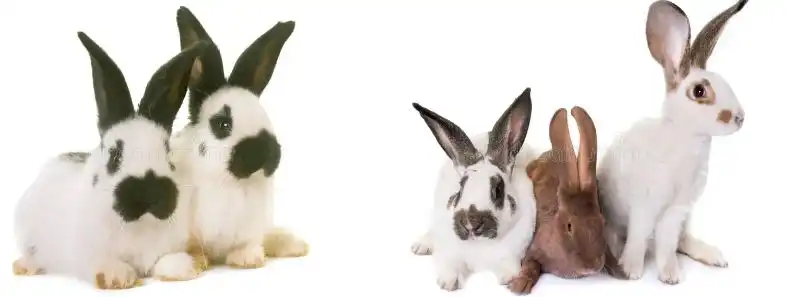The Angora rabbit is a fascinating and unique breed known for its long, soft wool. Originating from Turkey, these rabbits have become popular pets and are also bred for their luxurious fur. In this article, we’ll explore everything you need to know about Angora rabbits, from their history to their care requirements.
History of the Angora Rabbit
Origins: The Angora rabbit originated in Ankara, Turkey, formerly known as Angora. These rabbits were first brought to Europe in the 18th century. They quickly became popular among French royalty for their soft, silky wool.
From France, the Angora rabbit spread to other parts of Europe and eventually to America. Today, there are several breeds of Angora rabbits, each with unique characteristics.
Types of Angora Rabbits

English Angora
The English Angora is the smallest of the Angora breeds, typically weighing between 5 and 6 pounds. They have a compact body, a broad, flat head, and short ears. One of their most distinctive features is the fur on their face and ears, which gives them a unique, fluffy appearance.
The coat of an English Angora is thick, woolly, and silky. Unlike other Angora breeds, their entire body, including their feet, is covered in fur. This dense coat requires regular grooming to prevent matting and maintain its softness.
English Angoras are known for their gentle and docile nature. They are affectionate and can form strong bonds with their owners, especially those who take the time to groom them regularly. Their calm demeanor makes them excellent pets for families and individuals alike.
English Angora Grooming Needs
Due to their dense wool, English Angoras require frequent grooming. It’s essential to brush them at least twice a week to prevent wool block, a condition where ingested fur causes digestive issues. Regular grooming also helps keep their coat in top condition and reduces shedding.
English Angora Health and Care
English Angoras are generally healthy, but they are prone to wool block and other digestive issues if not properly groomed. Providing a balanced diet rich in fiber, such as timothy hay, and ensuring they have access to fresh water is vital. Regular veterinary check-ups are also important to monitor their health.
Uses of Wool of English Angora
The wool of English Angoras is highly prized for its softness and insulating properties. It is often used to make high-quality yarns and fabrics. Many crafters and artisans prefer Angora wool for its unique texture and warmth.
French Angora

The French Angora is one of the larger Angora breeds, typically weighing between 7.5 and 10.5 pounds. They have a commercial body type, which means they have a strong, sturdy frame. Unlike the English Angora, the French Angora has a clean face and front feet, with only minor tufting on the rear legs.
The coat of the French Angora is one of its most distinctive features. It consists of a combination of coarse guard hairs and soft underwool, which gives it a unique texture. The wool can grow up to six inches long, although the ideal length is about two to three inches. This wool is highly prized for its softness and warmth, making it a popular choice for spinning into yarn.
French Angoras Temperament
French Angoras are known for their gentle and docile nature. They are friendly and enjoy interacting with their owners. These rabbits are also quite playful and can be seen hopping around happily when given the space to do so. Their calm demeanor makes them suitable pets for families with older children and individuals who can dedicate time to their care.
Grooming Needs for French Angoras

Due to their dense wool, French Angoras require regular grooming to prevent matting and keep their coat in good condition. It’s recommended to brush them at least once a week, although more frequent grooming may be necessary during shedding seasons. Regular blow-drying can also help keep their coat clean and separate, as rabbits should not be bathed.
Health and Care of French Angoras
French Angoras are generally healthy, but they do require specific care to maintain their well-being. Wool block is a common issue, where ingested fur can cause digestive problems. Providing a diet rich in fiber, such as timothy hay, and ensuring they have access to fresh water is crucial. Regular veterinary check-ups are also important to monitor their health.
Uses of Wool of French Angoras
The wool of French Angoras is highly valued for its softness and insulating properties. It is often used to make high-quality yarns and fabrics. The wool is twice as water-absorbent as lamb’s wool and warmer than sheep’s wool, although it is not as flexible. This makes it a favorite among crafters and artisans who use it to create a variety of handmade items.
Giant Angora Rabbit

The Giant Angora is the largest of the Angora breeds. It was developed in the United States and is known for its high wool production. This breed requires extensive grooming due to its thick fur.
How big do Giant Angoras get?
The Giant Angora rabbit typically weighs between 9.5 and 12 pounds. They have a commercial body type with a large, oval head that is broad on the forehead and slightly narrower at the muzzle. Their ears are long and stand upright, often adorned with tufts of fur. The coat is dense and covers the entire body, including the face and feet.
The coat of the Giant Angora is its most distinctive feature. It consists of three types of wool: underwool, awn fluff, and awn hair. The underwool is the softest and densest, providing insulation. The awn fluff is slightly coarser, and the awn hair is the longest and coarsest, giving the coat its structure. This combination makes the wool highly prized for its warmth and softness.
Giant Angoras Temperament
Giant Angoras are known for their calm and gentle nature. They are affectionate and enjoy interacting with their owners. Their docile temperament makes them excellent pets for families and individuals who can dedicate time to their care.
Grooming Needs for Giant Angoras
Due to their dense and long wool, Giant Angoras require regular grooming to prevent matting and wool block. It’s essential to brush them at least twice a week and shear their wool every three to four months. Regular grooming helps maintain their coat’s quality and prevents health issues related to ingested fur.
Giant Angoras Rabbit : Health and Care
Giant Angoras are generally healthy but require specific care to maintain their well-being. Wool block is a common issue, where ingested fur can cause digestive problems. Providing a diet rich in fiber, such as timothy hay, and ensuring they have access to fresh water is crucial. Regular veterinary check-ups are also important to monitor their health.
Uses of Wool of Giant Angoras
The wool of Giant Angoras is highly valued for its softness and insulating properties. It is often used to make high-quality yarns and fabrics. The wool is lighter than sheep’s wool but warmer, making it ideal for crafting warm, hypoallergenic garments.
Satin Angora Rabbit

The Satin Angora has a unique sheen to its wool, making it highly prized. It is smaller than the Giant Angora but still produces a good amount of wool. Its fur is fine and silky, requiring regular care.
Physical Characteristics
The most distinctive feature of the Angora rabbit is its wool. The wool is soft, silky, and can grow up to 12 inches long. It is used to make high-quality yarns and fabrics.
Angora rabbits have a compact and sturdy body. Their ears are upright, and they have a gentle expression. The size and weight vary depending on the breed.
Angora Rabbit Care Requirements

Housing Angora rabbits
Angora rabbits need a spacious and clean living environment. A large cage or hutch with plenty of room to move around is ideal. Ensure the housing is well-ventilated and protected from extreme weather.
Angora Rabbit Diet: A Comprehensive Guide
Feeding Angora rabbits a balanced diet is crucial for their health, wool production, and overall well-being. Due to their continuous wool growth, Angora rabbits have specific nutritional needs. Let’s explore the essential components of their diet in detail.
Understanding Angora Rabbit Nutrition
Angora rabbits require a diet rich in fiber, protein, vitamins, and minerals to support their unique needs. A well-balanced diet helps maintain healthy wool production, supports digestive health, and ensures proper weight management.
Essential Components of an Angora Rabbit’s Diet

1. Fiber: The Foundation of Rabbit Health
Fiber is the cornerstone of a healthy rabbit diet. It is crucial for maintaining proper digestion and preventing gastrointestinal issues like stasis.
- Types of Fiber:
- Indigestible Fiber: Found in hay, it keeps the digestive system moving.
- Digestible Fiber: Present in fresh vegetables, it provides additional nutrients.
- Recommended Fiber Sources:
- Timothy Hay: The primary source of fiber for Angora rabbits.
- Orchard Grass: A good alternative to timothy hay.
- Meadow Hay: Provides variety in their diet.
- Oat Hay: Can be given in moderation.
Key Point: Hay should make up 70-80% of an Angora rabbit’s diet.
2. Protein: Fueling Wool Growth
Angora rabbits require higher protein levels than other rabbit breeds due to their continuous wool production.
- Optimal Protein Levels:
- Young Rabbits (under 1 year): 16-18%
- Adult Rabbits (maintenance): 12-14%
- Pregnant/Nursing Rabbits: 18-20%
- Protein Sources:
- High-Quality Pellets: Formulated specifically for Angora rabbits.
- Alfalfa Hay: Suitable for young, pregnant, or nursing rabbits.
- Leafy Greens: Can be given in moderation.
3. Carbohydrates: Energy for Daily Activities
While rabbits don’t need a high-carbohydrate diet, some carbs are necessary for energy.
- Appropriate Carbohydrate Sources:
- Commercial Rabbit Pellets: Should be given in moderation.
- Root Vegetables: Limited quantities, such as carrots.
- Fruits: Occasional treats, like apples or berries.
Caution: Avoid high-sugar fruits and vegetables to prevent obesity and dental issues.
4. Vitamins and Minerals: Supporting Overall Health
A varied diet ensures Angora rabbits receive essential vitamins and minerals.
- Key Vitamins and Minerals:
- Vitamin A: Supports vision and immune function.
- Vitamin D: Aids in calcium absorption.
- Vitamin E: Acts as an antioxidant.
- Calcium: Essential for bone health.
- Phosphorus: Works with calcium for bone strength.
- Sources of Vitamins and Minerals:
- Dark, Leafy Greens: Such as kale, spinach, and dandelion greens.
- Hay: Provides essential nutrients.
- Colorful Vegetables: Like bell peppers and carrots.
- Fortified Rabbit Pellets: Ensure a balanced intake.
5. Water: The Often Overlooked Nutrient
Fresh, clean water is important for Angora rabbits, especially given their thick coat. Ensure they have access to water at all times, either through a water bottle or a bowl.
Angora rabbits Feeding Schedule and Tips
Daily Feeding Routine
Establishing a regular feeding routine helps maintain your rabbit’s health and well-being.
- Morning:
- Fresh hay
- Check water supply
- Small amount of fresh greens
- Evening:
- Fresh hay
- Dried food or pellets
- Fresh greens
- Check water supply
Treats and Snacks of Angora rabbits
While treats can be a fun addition to your rabbit’s diet, they should be given sparingly.
- Safe Treats:
- Small pieces of fruit (e.g., apple slices, berries)
- Root vegetables (e.g., carrot slices)
- Avoid:
- High-sugar fruits and vegetables
- Commercial treats high in sugar
Feeding Angora rabbits a balanced diet is essential for their health and wool production. By focusing on high-quality hay, appropriate pellets, fresh vegetables, and limited treats, you can ensure your Angora rabbit remains healthy and happy. Regularly monitoring their diet and adjusting as needed will help them thrive.
Conclusion
Feeding Angora rabbits a balanced diet is essential for their health and wool production. By focusing on high-quality hay, appropriate pellets, fresh vegetables, and limited treats, you can ensure your Angora rabbit remains healthy and happy. Regularly monitoring their diet and adjusting as needed will help them thrive.




